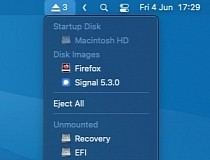Jay Alan Sekulow (/ ˈ s ɛ k j ə ˌ l oʊ /; born June 10, 1956) is an American lawyer, radio, television talk show host and politically conservative media personality. He has been chief counsel of the American Center for Law & Justice (ACLJ) since 1991. As a member of President Donald Trump's legal team, he served as lead outside counsel for Trump's First Impeachment Trial in the United. Jay Alan Sekulow (/ ˈ s ɛ k j ə ˌ l oʊ /; born June 10, 1956) is an American lawyer, radio, television talk show host and politically conservative media personality. He has been chief counsel of the American Center for Law & Justice (ACLJ) since 1991.
At a Glance

Expert’s Rating
Cons
Our Verdict
I have quite a few drives—internal and external—connected to my Mac, and because of my work testing software for Mac Gems, I download and mount many disk images each day. I also connect to several network shares and drives. Since I prefer not to clutter my Desktop with all these volumes, they’re visible only in Finder-window sidebars. But because I have so many volumes connected, I choose to hide many of them in the sidebar, as well. This approach is great for keeping my onscreen workspace neat, but it makes it a bit of a hassle to eject drives and images. (Even for those volumes displayed in the sidebar, if no Finder windows are open and visible, I have to switch to the Finder and open a new window just to eject.)
This is admittedly a minor problem, but one that led me to look for a more-convenient solution for ejecting volumes. I found it in Kevin Wojniak’s free Semulov 1.3 (). Semulov—volumes spelled backwards, in case you missed it—adds an eject icon to your menu bar; click on this icon to view a menu of all currently-mounted volumes—hard drives, flash drives, CDs, DVDs, network volumes, iPods, disk images…anything that can be mounted and ejected in the Finder. (Semulov conveniently groups items by type.) Choose a volume from the menu and it’s immediately ejected/unmounted, or choose the Eject All command to quickly eject all mounted volumes. (There’s a useful option to prevent internal drives from being unmounted and, of course, Semulov never tries to unmount the startup disk.)
Semulov also provides a number of display options. For example, it can display, next to its menu-bar icon, the number of mounted volumes, and you can choose to prevent the startup disk and internal hard drives from appearing in the menu. Growl support provides onscreen confirmation whenever a volume is mounted or ejected.
Simulovani I Disimulovani Pravni Poslovi
On the other hand, there’s no documentation, so you’re left to guess what some options do. For example, I couldn’t determine the purpose of “Disable warning dialog when discarding disk images”—it didn’t prevent me from seeing a warning if I tried to eject a disk image when a file on that image was open, at least. I also discovered one minor glitch: If you rename a volume in the Finder, Semulov’s menu won’t reflect that change until you relaunch Semulov or eject and re-mount the renamed volume.
Two things I’d like to see in future versions: First, when ejecting a partition of a multi-partitioned drive, I’d like the option—offered by Leopard’s Finder—to eject all partitions of that volume. Second, it would be useful if, like Disk Utility, Semulov displayed volumes connected but not mounted and gave you the option to mount each.
If, like me, you work with lots of drives and disk images, Semulov is a great solution to a minor—but frequent—inconvenience.
Semulov 1.3 requires Mac OS X 10.4 or later.
Categories include disk imaging, hard drives, network devices, DVDs, FTPs, iPods, and iDisks. Dismounting sounds from one of these is as simple as clicking the left button on its name.
The number at the end of the program icon in the menu bar indicates the number of active volumes. Semulov uses Growl notifications to show when a volume has been mounted or dismounted.
Smulovics
Notes
Descargar Semulv
For OS X 10.4 or later.